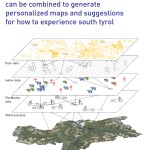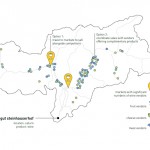Text: MIT SENSEable City Lab / Illustratiions: Jennifer Dunnam
The past years have seen a rising interest for quality grown, fresh and local produce distributed through farmer’s markets, on-site-purchases or mobile vendors. Food markets and street vendors have existed since the earliest town settlements were formed and mobility was once a critical feature for adapting to seasonal changes and city dynamics. Today’s farmer’s markets operate around fixed schedules and locations, which limit their exposure and rarely reflect supply and demand fluctuations. As cities continue to grow in size and complexity with urban populations increasingly connected and mobile, there arises an opportunity to re-examine food distribution strategies and design the farmer’s market in a way that improves efficiency by enhancing communication between producers and consumers. MatchingMarkets is a mobile network of vendors using real-time communication to optimize distribution, increase awareness of local products, respond to seasonal activity patterns, and strengthen connections between local supply and demand.
Vendors’ vehicles are tracked using a GPS device, which sends location data to the system platform. Together with this, information is broadcasted on products on offer including details of type, price, production, and origin. Through an online interface, people can browse the “internet of food” while their location and interests are anonymously collected for use by vendors seeking better locations and strategies for selling products. Tourists can also view location data to find populated areas where events are taking place or avoid crowds where clusters emerge on the map. As the network around MatchingMarkets grows, farmers can build stronger relationships with frequent customers while locals and tourists can increase their knowledge of regional agriculture and indulge in the seasonal nuances of homegrown products.
MatchingMarkets is currently being investigated in the region of South Tyrol, where over 25,000 farmsteads are currently operating and nearly 5 million tourists visit each year. There is a significant distinction between urban life in valleys and farming culture on the hillsides and urban dwellers often lack adequate and up-to-date information on which local produce is available and where they can find it. At the same time, vendors struggle to accommodate for seasonal and event driven variations in tourist activities in their planning. By tapping into vast open data sets that reflect user behavior and combining these with data collected from the market’s operation, new opportunities emerge to optimize local exchange in South Tyrol and match supply with demand throughout the changing seasons.
Credits & info:
Team: Jennifer Dunnam – project leader, Kristian Kloeckl – group leader, Diego Maniloff, Anthony Vanky, Carlo Ratti – director, Assaf Biderman – assoc. director
Support: Fabien Girardin, Bernd Resch, Görgen & Köller GmbH
Partnership: TIS innovaton park
Made possible by: Stiftung Südtiroler Sparkasse, Fondazione Cassa di Risparmio



